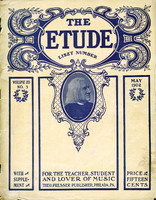Liszt is now [1840] probably about thirty years old. Everyone knows well that he was a child phenomenon; how he was early transplanted to foreign lands; that his name afterward appeared here and there among the most distinguished; that then the rumor of it occasionally died away, until Paganini appeared, inciting the youth to new endeavors; and that he suddenly appeared in Vienna two years ago, rousing the imperial city to enthusiasm. Thus he appeared among us of late, already honored, with the highest honors that can be bestowed on an artist, and his fame already established.
The first concert, on the 17th, was a remarkable one. The multitudinous audience was so crowded together that even the hall looked altered. The orchestra was also filled with listeners, and among them—Liszt.
He began with the Scherzo and Finale of Beethoven’s “Pastoral Symphony.” The selection was capricious enough, and on many accounts not happy. At home, in a tete-a-tete, a highly careful transcription may lead one almost to forget the orchestra; but in a large hall, in the same place where we have been accustomed to hear the symphony played frequently and perfectly by the orchestra, the weakness of the pianoforte is striking, and the more so the more an attempt is made to represent masses in their strength. Let it be understood, with all this, we had heard the master of the instrument; people were satisfied; they at least, had seen him shake his mane. To hold to the same illustration, the lion presently began to show himself more powerful. This was in a fantasia on themes by Pacini, which he played in a most remarkable manner. But I would sacrifice all the astonishing, the audacious bravura that he displayed here for the sake of the magical tenderness that he expressed in the following etude. With the sole exception of Chopin, as I have already said, I know not one who equals him in this quality. He closed with the well-known Chromatic Galop; and as the applause this elicited was endless, he also played his equally well-known bravura waltz.
Fatigue and indisposition prevented the artist from giving the concert promised for the next day. In the meantime a musical festival was prepared for him, that will never be forgotten by Liszt himself or the others present. The giver of the festival (Felix Mendelssohn) had selected for performance some compositions unknown to his guest: Franz Schubert’s symphony (in C); his own psalm, “As the Hart Pants”; the overture, “A Calm Sea and a Prosperous Voyage”; three choruses from “St. Paul”; and, to close with, the D-minor concerto for three pianos by Sebastian Bach. This was played by Liszt, Mendelssohn, and Hiller. It seemed as though nothing had been prepared, but all improvised instantaneously. Those were three such happy musical hours as years do not always bring. At the end Liszt played alone, and wonderfully.
Liszt’s most genial performance was yet to come— Weber’s Concertstück, which he played at his second concert. Virtuoso and public seemed to be in the freshest mood possible on that evening, and the enthusiasm before and after his playing exceeded anything hitherto known here. Although Liszt grasped the piece from the beginning, with such force and grandeur of expression that an attack on a battle-field would seem to be in question, yet he carried this on with continually increasing power, until the passage where the player seemed to stand at the summit of the orchestra, leading it forward in triumph. Here, indeed, he resembled that great commander to whom he has been compared, and the tempestuous applause that greeted him was not unlike an adoring “Vive l’Empereur!” He then played a fantasia on themes from the “Huguenots,” the “Ave Maria” and “Serenade,” and, at the request of the public, the “Erl-King” of Schubert. But the Concertstück was the crown of his performances on this evening.—From Schumann’s Collected Writings.



